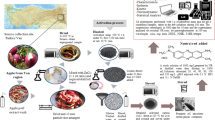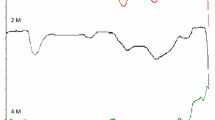Abstract
This work reports utilization of apple leaves as a source of activated carbon. Activated carbon from apple leaves is prepared by two different methods, thermal activation where AC1 is obtained and chemical activation using H3PO4 and ZnCl2 where AC2 and AC3 are obtained, respectively. XRD analysis revealed that all types of prepared ACs have a semi-crystalline nature with a mean crystallite size of 13, 21.02, and 39.47 nm for AC1, AC2, and AC3, respectively. To identify the most suitable desorption temperature, the exothermic behavior was discovered for the three types of ACs by DSC. The exothermic onset temperatures are 340 °C, 200 °C, 400 °C, or AC1, AC2, and AC3, respectively. The point of zero charge for the three types of ACs is 8.6, 7.3, and 2.5 for AC1, AC2, and AC3, respectively. The BET surface area analysis data demonstrated that mesoporous structure was developed in AC1 and AC2, while a microporous structure was developed in AC3. Quantum chemical calculations for ACs is carried out using Density Functional Theory (DFT). Application of the prepared ACs in adsorption of basic dye C.I. base blue 47 is studied. The maximum removal efficiency was 65.1%, 96% and 99% for AC1, AC2, and AC3, respectively under the influence of different operating aspects. Adsorption data are modeled by Langmuir, Freundlich, and Temkin isotherms. The data revealed that adsorption of basic dye C.I. base blue 47 on AC1 follows Langmuir isotherm and adsorption on AC2 and AC3 follows Freundlich isotherm.
Access this article
We’re sorry, something doesn't seem to be working properly.
Please try refreshing the page. If that doesn't work, please contact support so we can address the problem.
















Similar content being viewed by others
Abbreviations
- \( {\text{A}}_{\text{T}} \) :
-
Temkin isotherm equilibrium binding constant, L g−1
- \( \text{B}_{\text{T}} \) :
-
Constant related to heat of sorption, J mol−1
- \( {\text{b}}_{\text{T}} \) :
-
Temkin isotherm constant
- \( C_{o} \) :
-
Initial concentrations of the dye in solution, mg L−1
- \( C_{e} \) :
-
Final concentrations of the dye in solution, mg L−1
- D:
-
Crystal size
- EgHOMO :
-
Energy of the highest occupied molecular orbital
- EgLUMO :
-
Energy of the lowest unoccupied molecular orbital
- k:
-
Constant (k = 0.9)
- \( K_{F} \) :
-
Freundlich adsorption equilibrium constant, L g−1
- KL :
-
Langmuir equilibrium constant, L mg−1
- m :
-
Mass of the adsorbent, g
- n :
-
Freundlich intensity factor
- \( q_{e} \) :
-
Equilibrium adsorption capacity, mg g−1
- \( q_{m} \) :
-
Theoretical maximum monolayer adsorption capacity, mg g−1
- \( q_{t} \) :
-
Amount of dye adsorbed per unit mass of adsorbent, mg.g−1
- R :
-
Universal gas constant (8.314 J mol−1.K−1)
- S :
-
Global softness
- T :
-
Temperature, K
- V :
-
Solution volume in, L
- β :
-
Full Width at Half Maximum of the peak (FWHM)
- \( \eta \) :
-
Global chemical hardness of the concerned chemical system
- θ :
-
Bragg angle
- λ :
-
X-ray wavelength (1.54 Å)
- \( \mu \) :
-
Chemical potential (i.e., negative of electrophilicity)
- χ :
-
electronegativity
- \( \omega \) :
-
Global electrophilicity
References
Sulyman M, Namiesnik J, Gierak A (2014) Utilization of new activated carbon derived from oak leaves for removal of crystal violet from aqueous solution. Polish J Environ Stud 23:2223–2232
Campanella A, Wool RP, Bah M, Fita S, Abuobaid A (2013) Composites from northern red oak (Quercus robur) leaves and plant oil-based resins. Journal of Applied Polymer Science 127:18–26
Rahman IA, Saad B, Shaidan S, Sya Rizal ES (2005) Adsorption characteristics of malachite green on activated carbon derived from rice husks produced by chemical–thermal process. Bioresour Technol 96:1578–1583.
Dang VBH, Doan HD, Dang-Vu T, Lohi A (2009) Equilibrium and kinetics of biosorption of cadmium (II) and copper (II) ions by wheat straw. Bioresource Technology 100:211–219
Fasakin O, Dangbegnon JK, Momodu DY, Madito MJ, Oyedotun KO, Eleruja MA, Manyala N (2018) Synthesis and characterization of porous carbon derived from activated banana peels with hierarchical porosity for improved electrochemical performance. Electrochimica Acta 262:187–196
Jacques AR, Lima EC, Dias SLP, Mazzocato AC, Pavan FA (2007) Yellow passion-fruit shell as biosorbent to remove Cr (III) and Pb (II) from aqueous solution. Sep Purif Technol 57:193–198.
Mahamad MN, Abbas M, Zaini A, Zakaria ZA (2015) Preparation and characterization of activated carbon from pineapple waste biomass for dye removal. Int Biodeter Biodegrad 102:274–280.
Sivasankar V, Rajkumar S, Murugesh S, Darchen A (2012) Tamarind (Tamarindus indica) fruit shell carbon: a calcium-rich promising adsorbent for fluoride removal from groundwater. J Hazard Mater 225:164–172
Girgis B, Yunis SS, Soliman AM (2002) Characteristics of activated carbon from peanut hulls in relation to conditions of preparation. Mater Lett 57:164–172
Liu W, Liu Y, Tao Y, Yu Y, Jiang H, Lian H (2014) Comparative study of adsorption of Pb (II) on native garlic peel and mercerized garlic peel. Environ Sci Pollut Res 21:2054–2063
Fernandez ME, Nunell GV, Bonelli PR, Cukierman AL (2014) Activated carbon developed from orange peels: Batch and dynamic competitive adsorption of basic dyes. Ind Crops Products 62:437–445
Azharul Islam M, Benhouria A, Asif M, Hameed BH (2015) Methylene blue adsorption on factory-rejected tea activated carbon prepared by conjunction of hydrothermal carbonization and sodium hydroxide activation processes. J Taiwan Inst Chem Eng 52:57–64.
Demir H, Top A, Balköse D, Ülkü S (2008) Dye adsorption behavior of Luffa cylindrica fibers. J Hazard Mater 153:389–394
Sharma A, Bhattacharyya KG (2005) Adsorption of chromium (VI) on Azadirachta indica (neem) leaf powder. Adsorption 10:327–338
Babel S, Kurniawan TA (2003) Low-cost adsorbents for heavy metals uptake from contaminated water: a review. J Hazard Mater 97:219–243
Abdel-Hamid SMS, Al-Qabandi OA, Elminshawy NAS, Bassyouni M, Zoromba MS, Abdel-Aziz MH, Mira H, Elhenawy Y (2019) Fabrication and characterization of microcellular polyurethane sisal biocomposites. Molecules 24:4585
Baek J, Lee H, An K, Kim B (2019) Preparation and characterization of highly mesoporous activated short carbon fibers from kenaf precursors. Carbon Lett 29:393–399
Lee H, Lee B, Kim J, An K, Park S, Kim B (2019) Determination of the optimum porosity for 2-CEES adsorption by activated carbon fiber from various precursors. Carbon Lett 29:649–654
Mopoung S, Moonsri P, Palas W, Khumpai S (2015) Characterization and properties of activated carbon prepared from tamarind seeds by KOH activation for Fe (III) adsorption from aqueous solution. Sci World J 2015
Vasiliev LL, Kanonchik LE, Kulakov AG, Mishkinis DA, Safonova AM, Luneva NK (2006) Activated carbon fiber composites for ammonia, methane and hydrogen adsorption. Int J Low-Carbon Technol 1:95–111
Pérez-Ramírez EE, de la Luz-Asunción M, Martínez-Hernández AL, de la Rosa-Álvarez G, Fernández-Tavizón S, Salas P, Velasco-Santos CJCL (2019) One-and two-dimensional carbon nanomaterials as adsorbents of cationic and anionic dyes from aqueous solutions. Carbon Lett 29:155–166
Faizal ANM, Abdul Halim MH, Zaini MAA (2019) Kinetics and dynamic adsorption of methylene blue by CO2-activated resorcinol formaldehyde carbon gels. Carbon Lett 29:319–326.
Worch E (2012) Adsorption technology in water treatment: fundamentals, processes, and modeling. Walter de Gruyter, Berlin
Elhady S, Bassyouni M, Mansour RA, Elzahar MH, Abdel-Hamid S, Elhenawy Y, Saleh MY (2020) Oily wastewater treatment using polyamide thin film composite membrane technology. Membranes 10:84
Zoromba MSh, Ismail MIM, Bassyouni M, Abdel-Aziz MH, Salah N, Alshahrie A, Memic A (2017) Fabrication and characterization of poly (aniline-co-o-anthranilic acid)/magnetite nanocomposites and their application in wastewater treatment. Colloid Surf A Physicochem Eng Aspects 520:121–130
Abdel-Aziz MH, Bassyouni M, Zoromba MSh, Alshehri AA (2019) Removal of dyes from waste solutions by anodic oxidation on an array of horizontal graphite rods anodes. Ind Eng Chem Res 58:1004–1018
Gutub SA, Bassyouni M, Abdel-Hamid SMS (2013) Dissolved solids adsorption of freshwater using synthesized bio-foam composite. Life Sci J 10:464–471
Bonazzi P, Lepore GO, Bindi L, Chopin C, Husdal TA, Medenbach O (2014) Perbøeite-(Ce) and alnaperbøeite-(Ce), two new members of the epidote-törnebohmite polysomatic series: chemistry, structure, dehydrogenation, and clue for a sodian epidote end-member. Am Mineral 99:157–169
Ibrahim A, Abdel-Aziz MH, Sh Zoromba M, Al-Hossainy AF (2018) Structural, optical, and electrical properties of multi-walled carbon nanotubes/polyaniline/Fe3O4 ternary nanocomposites thin film. Synthetic Metals 238:1–13
Engel P, Nowacki W (1970) Die Kristallstruktur von Rathit-II [As25S56| Pb6, VII5 5 Pb IX12 ]. Zeitschrift für Kristallographie-Crystalline Materials 131:356–375.
Ahmad A, Hameed B (2010) Fixed-bed adsorption of reactive azo dye onto granular activated carbon prepared from waste. J Hazard Mater 175:298–303
Al-Hossainy A, Thabet HK, Zoromba MSh, Ibrahim A (2018) Facile synthesis and fabrication of a poly (ortho-anthranilic acid) emeraldine salt thin film for solar cell applications. N J Chem 42:10386–10395
Hanafy TA (2012) Dielectric relaxation and Schottky conduction of IR laser irradiated Makrofol-DE polycarbonate. J Appl Polym Sci 124:1–8
Abdel-Aziz M, Al-Hossainy A, Ibrahim A, El-Maksoud SA, Zoromba MS, Bassyouni M, Abdel-Hamid S, Abd-Elmageed A, Elsayed I, Alqahtani O (2018) Synthesis, characterization and optical properties of multi-walled carbon nanotubes/aniline-o-anthranilic acid copolymer nanocomposite thin films. J Mater Sci Mater Electron 29:16702–16714
Zoromba MSh, Abdel-Aziz M, Bassyouni M, Bahaitham H, Al-Hossainy A (2018) Poly (o-phenylenediamine) thin film for organic solar cell applications. J Solid State Electrochem 22:3673–3687
Zoromba MSh, Bassyouni M, Abdel-Aziz MH, Al-Hossainy AF, Salah N, Al-Ghamdi AA, Eid MR (2019) Structure and photoluminescence characteristics of mixed nickel–chromium oxides nanostructures. Appl Phys A 125:642
Zoromba MSh, Al-Hossainy AF, Abdel-Aziz MH (2017) Conductive thin films based on poly (aniline-co-o-anthranilic acid)/magnetite nanocomposite for photovoltaic applications. Synthetic Metals 231:34–43
de Oliveira F, Eugênia M, Vaz BG, Borba CE, Alonso CG, Ostroski IC (2019) Modified activated carbon as a promising adsorbent for quinoline removal. Microporous Mesoporous Mater 277:208–216
Muller JCM, Hakvoort G, Jansen JC (1998) DSC and TG study of water adosorption and desorption on zeolite NaA powder and attached as layer on metal. J Thermal Anal Calorimetry 53:449–466
Baudu M, Le Cloirec P, Martin G (1993) First approach of desorption energies of water and organic molecules onto activated carbon by differential scanning calorimetry studies. Water Res 27:69–76
Naderi M (2015) Surface Area: Brunauer–Emmett–Teller (BET), In Progress in filtration and separation, Academic Press, New York, pp 585–608
Duan X, Srinivasakannan C, Yang K, Peng J, Zhang L (2012) Effects of heating method and activating agent on the porous structure of activated carbons from coconut shells. Waste and Biomass Valorization 3:131–139
Yaman S (2004) Pyrolysis of biomass to produce fuels and chemical feedstocks. Energy Convers Manag 45:651–671
Ukanwa KS, Patchigolla K, Sakrabani R, Anthony E, Mandavgane S (2019) A review of chemicals to produce activated carbon from agricultural waste biomass. Sustainability 11:6204
Faria PCC, Órfáo JJM, Pereira MFR (2004) Adsorption of anionic and cationic dyes on activated carbons with different surface chemistries. Water Res 38:2043–2052
Parr RG, Donnelly RA, Levy M, Palke WE (1978) Electronegativity: the density functional viewpoint. J Chem Phys 68:3801–3807
Sanderson RT (1976) Chemical bond and bond energies. Academic, New York
Al-Hossainy AF, Sh Zoromba M (2019) Doped-poly (para-nitroaniline-co-aniline): synthesis, semiconductor characteristics, density, functional theory and photoelectric properties. J Alloys Compound 789:670–683
A. F. Al-Hossainy, M. Sh Zoromba, O. A. El-Gammal, Farid I. El-Dossoki, Density functional theory for investigation of optical and spectroscopic properties of zinc-quinonoid complexes as semiconductor materials. Structural Chemistry 30 (2019) 1–16.
Mulliken RS (1934) A new electroaffinity scale; together with data on valence states and on valence ionization potentials and electron affinities. J Chem Phys 2:782–793
Maynard AT, Huang M, Rice WG, Covell DG (1998) Reactivity of the HIV-1 nucleocapsid protein p7 zinc finger domains from the perspective of density-functional theory. Proc Natl Acad Sci 95:11578–11583
Parr RG, Szentpály LV, Liu S (1999) Electrophilicity index. J Am Chem Soc 121:1922–1924
Thabet HKh, Al-Hossainy AF, Imran M (2020) Synthesis, characterization, and DFT modeling of novel organic compound thin films derived from 2-amino-4-(2-hydroxy-3-methoxyphenyl)-4H-thiazolo [3, 2-a][1, 3, 5] triazin-6 (7H)-one. Opt Mater 105:109915
Abd-Elmageed AAI, Al-Hossainy AF, Fawzy EM, Almutlaq N, Eid MR, Bourezgui A, Abdel-Hamid SMS, Elsharkawy NB, Zwawi M, Abdel-Aziz MH, Bassyouni M (2020) Synthesis, characterization and DFT molecular modeling of doped poly (para-nitroaniline-co-para-toluidine) thin film for optoelectronic devices applications. Opt Mater 99:109593
Magdy A, Fouad YO, Abdel-Aziz MH, Konsowa AH (2017) Synthesis and characterization of Fe3O4/kaolin magnetic nanocomposite and its application in wastewater treatment. J Ind Eng Chem 56:299–311
Bhattacharyya KG, Gupta SS (2008) Influence of acid activation on adsorption of Ni (II) and Cu (II) on kaolinite and montmorillonite: kinetic and thermodynamic study. Chem Eng J 136:1–13
Khan TA, Dahiya S, Ali I (2012) Use of kaolinite as adsorbent: Equilibrium, dynamics and thermodynamic studies on the adsorption of Rhodamine B from aqueous solution. Appl Clay Sci 69:58–66
Mahmoud ME, Nabil GM, El-Mallah NM, Bassiouny HI, Kumar S, Abdel-Fattah TM (2016) Kinetics, isotherm, and thermodynamic studies of the adsorption of reactive red 195 A dye from water by modified Switchgrass Biochar adsorbent. Journal of Industrial and Eng Chem 37:156–167
Sun X, Ou H, Miao C, Chen L (2015) Removal of Sudan dyes from aqueous solution by magnetic carbon nanotubes: equilibrium, kinetic and thermodynamic studies. J Ind Eng Chem 22:373–377
Zhang Y, Zhu C, Liu F, Yuan Y, Wu H, Li A (2019) Effects of ionic strength on removal of toxic pollutants from aqueous media with multifarious adsorbents: a review. Sci Total Environ 646:265–279
Fosso-Kankeu E, Mittal H, Waanders F, Ray SS (2017) Thermodynamic properties and adsorption behaviour of hydrogel nanocomposites for cadmium removal from mine effluents. J Eng Chem 48:151–161
Doğan M, Alkan M, Turkyїlmaz A, Ozdemir Y (2004) Kinetics and mechanism of removal of methylene blue by adsorption onto perlite. J Hazard Mater 109:141–148
Abdel-Aziz MH, Gutub S, Soliman MF, Bassyouni M (2016) Removal of Fe++ from Wastewater Using Sludge-polymer Hybrid Adsorbents. Rocznik Ochrona Środowiska 18:28–45
Liu R, Zhang B, Mei D, Zhang H, Liu J (2011) Adsorption of methyl violet from aqueous solution by halloysite nanotubes. Desalination 268:111–116
Tempkin MI, Pyzhev V (1940) Kinetics of ammonia synthesis on promoted iron catalyst. Acta Phys Chim USSR 12:327
Author information
Authors and Affiliations
Corresponding author
Ethics declarations
Conflict of interest
None of the authors of the manuscript has declared any conflict of interest.
Data availability statements
The data that support the findings of this study are available from the corresponding author upon reasonable request.
Additional information
Publisher's Note
Springer Nature remains neutral with regard to jurisdictional claims in published maps and institutional affiliations.
Rights and permissions
About this article
Cite this article
Abdel-Aziz, M.H., El-Ashtoukhy, E.Z., Bassyouni, M. et al. DFT and experimental study on adsorption of dyes on activated carbon prepared from apple leaves. Carbon Lett. 31, 863–878 (2021). https://doi.org/10.1007/s42823-020-00187-1
Received:
Revised:
Accepted:
Published:
Issue Date:
DOI: https://doi.org/10.1007/s42823-020-00187-1




